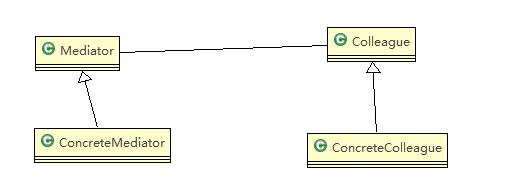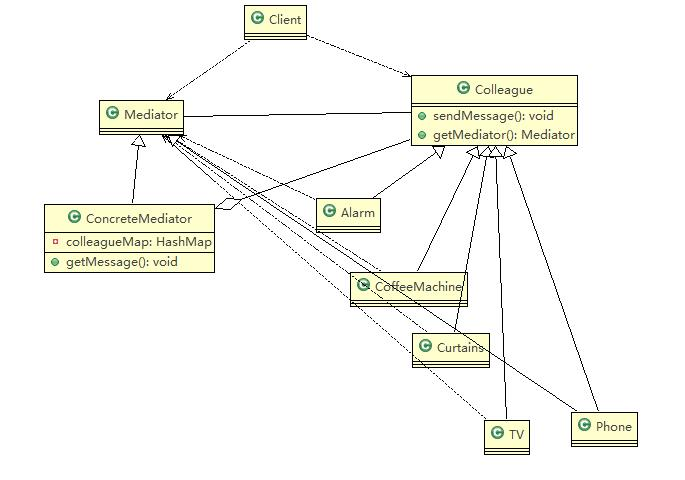中介者模式
一、中介者模式(Mediator Pattern)
1.基本介绍
1)用一个中介对象来封装一系列的对象交互。中介者使各个对象不需要显式地相互引用,从而使其耦合松散,而且可以独立地改变它们之间的交互
2)中介者模式属于行为型模式,使代码易于维护
3)比如MVC模式,C(Controller控制器)是M(Model模型)和V(View视图)的中介者,在前后端交互时起到了中间人的作用
2.原理类图

1)Mediator就是抽象中介者,定义了同事对象到中介者对象的接口
2)Colleague抽象同事类
3)ConcreteMediator 具体中介者对象,实现抽象方法,他需要知道所有的具体的同事类,即以一个集合来管理HashMap,并接受某个同事对象消息,完成相应的任务
4)ConcreteColleague具体的同事类,每个同事只知道自己的行为,而不了解其他同事类的行为(方法),都依赖中介者对象
二、应用实例
1.实例要求
智能家庭项目:
1)智能家庭包括各种设备,闹钟、咖啡机、电视机、窗帘等
2)主人要看电视时,各个设备可以协同工作,自动完成看电视的准备工作,比如流程为:闹铃响起>咖啡机开始做咖啡->窗帘自动落下>电视机开始播放
2. 思路分析

3.代码实现
public class ClientTest {
public static void main(String[] args) {
//创建一个中介者对象
Mediator mediator = new ConcreteMediator();
//创建Alarm 并且加入到 ConcreteMediator 对象的HashMap
Alarm alarm = new Alarm(mediator, "alarm");
//创建了CoffeeMachine 对象,并 且加入到 ConcreteMediator 对象的HashMap
CoffeeMachine coffeeMachine = new CoffeeMachine(mediator,
"coffeeMachine");
//创建 Curtains , 并 且加入到 ConcreteMediator 对象的HashMap
Curtains curtains = new Curtains(mediator, "curtains");
TV tV = new TV(mediator, "TV");
//让闹钟发出消息
alarm.SendAlarm(0);
coffeeMachine.FinishCoffee();
alarm.SendAlarm(1);
}
}
//同事抽象类
public abstract class Colleague {
private Mediator mediator;
public String name;
public Colleague(Mediator mediator, String name) {
this.mediator = mediator;
this.name = name;
}
public Mediator GetMediator() {
return this.mediator;
}
public abstract void SendMessage(int stateChange);
}
//具体的同事类
public class Alarm extends Colleague {
//构造器
public Alarm(Mediator mediator, String name) {
super(mediator, name);
//在创建Alarm 同事对象时,将自己放入到ConcreteMediator 对象中[集合]
mediator.Register(name, this);
}
public void SendAlarm(int stateChange) {
SendMessage(stateChange);
}
@Override
public void SendMessage(int stateChange) {
//调用的中介者对象的getMessage
this.GetMediator().GetMessage(stateChange, this.name);
}
}
// 抽象中介者
public abstract class Mediator {
//将给中介者对象,加入到集合中
public abstract void Register(String colleagueName, Colleague colleague);
//接收消息, 具体的同事对象发出
public abstract void GetMessage(int stateChange, String colleagueName);
public abstract void SendMessage();
}
//具体的中介者类
public class ConcreteMediator extends Mediator {
//集合,放入所有的同事对象
private HashMap<String, Colleague> colleagueMap;
private HashMap<String, String> interMap;
public ConcreteMediator() {
colleagueMap = new HashMap<String, Colleague>();
interMap = new HashMap<String, String>();
}
@Override
public void Register(String colleagueName, Colleague colleague) {
colleagueMap.put(colleagueName, colleague);
if (colleague instanceof Alarm) {
interMap.put("Alarm", colleagueName);
} else if (colleague instanceof CoffeeMachine) {
interMap.put("CoffeeMachine", colleagueName);
} else if (colleague instanceof TV) {
interMap.put("TV", colleagueName);
} else if (colleague instanceof Curtains) {
interMap.put("Curtains", colleagueName);
}
}
//具体中介者的核心方法
//1. 根据得到消息,完成对应任务
//2. 中介者在这个方法,协调各个具体的同事对象,完成任务
@Override
public void GetMessage(int stateChange, String colleagueName) {
//处理闹钟发出的消息
if (colleagueMap.get(colleagueName) instanceof Alarm) {
if (stateChange == 0) {
((CoffeeMachine) (colleagueMap.get(interMap
.get("CoffeeMachine")))).StartCoffee();
((TV) (colleagueMap.get(interMap.get("TV")))).StartTv();
} else if (stateChange == 1) {
((TV) (colleagueMap.get(interMap.get("TV")))).StopTv();
}
} else if (colleagueMap.get(colleagueName) instanceof CoffeeMachine) {
((Curtains) (colleagueMap.get(interMap.get("Curtains"))))
.UpCurtains();
} else if (colleagueMap.get(colleagueName) instanceof TV) {
//如果TV发现消息
} else if (colleagueMap.get(colleagueName) instanceof Curtains) {
//如果是以窗帘发出的消息,这里处理...
}
}
@Override
public void SendMessage() {
}
}
三、中介者模式注意事项
1)中介者承担了较多的责任,一旦中介者出现了问题,整个系统就会受到影响。
2)多个类相互耦合,会形成网状结构,使用中介者模式将网状结构分离为星型结构,进行解耦。